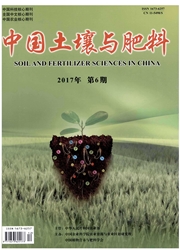

 中文摘要:
中文摘要:
可溶性有机碳(DOC)吸附影响土壤元素化学行为。为此,本研究采用批处理法研究了DOC在长期不同施肥处理(对照CK、氮N、氮磷NP、氮磷钾NPK、化肥+秸秆还田NPKS、化肥+有机肥NPKM)潮土上的吸附动力学和等温吸附特征。结果表明,猪粪源DOC易于分解,需要添加0.025 mmol(1 mL 25 mmol/L)Na N3抑制其分解,抑制率超过90%。DOC吸附符合准二级动力学方程(R~2≥0.99)。不同施肥处理下,吸附速率常数k及初始速率常数h与平衡吸附Qe都没有显著差异,平均值分别为0.208 kg/(g·h)、1.60 g/(kg·h)和2.77g/kg。吸附等温式可用Langmuir方程很好拟合(R~2≥0.96),吸附容量(最大吸附量)Q_(max)在不同施肥处理下也没有显著差异(平均7.05 g/kg),但在N和NP等非平衡施肥下却保持高的亲合力,半饱和吸附浓度k_d分别为50.2和57.6 mg/L,吸附亲合常数K则分别为0.02和0.017 4 L/mg;相反,在NPKM处理下,显著低的亲合性发生,k_d和K分别为72.94 mg/L和0.013 8 L/mg。研究证明粘粉粒含量控制了不同施肥处理潮土对DOC的吸附;土壤有机碳水平不影响Q_(max),而且高土壤有机碳还降低其吸附亲合性。
 英文摘要:
英文摘要:
The adsorption characteristics of dissolved organic carbon (DOC) on soils affected soil element chemistry. In this study, the adsorption kinetics and isotherm adsorption of DOC were investigated by batch methods on a fluvo-aquic soil with dif- ferent fertilizer application including control (without fertilizer, CK), nitrogen (N), nitrogen and phosphorus (NP), nitrogen and phosphorus and potassium (NPK), chemical fertilizer and straw return (NPKS), and chemical fertilizer and manure (NPKM). The results showed that 0. 025 mmol ( 1 mL 25 mmol/L) NaN3 need to be added to inhibit the decomposition of DOC derived from dry swine manure during DOC adsorption processes, and the inhibitory rate of it was more than 90%. The kinetic data were fitted to pseudo-second-order model (R2 〉10. 99), where there were insignificant difference in rate constant (k) , ini- tial sorption rate (h) and amount of adsorbed at equilibrium (Qe) among different fertilization treatments, with average values of 0. 208 kg/(g h), 1.60 g/( kg h), and 2. 77 g/kg, respectively. Further, the Langmuir model was used to describe the adsorption isotherm (R2 ≥0. 96), and there was also insignificant difference in maximum adsorption amount (Qmax) among dif- ferent treatments, with the average 7.05 g/kg. However, the affinity had significant difference among treatments, the higher affinity occurred in N and NP treatments, which had lower concentrations for half of maximum adsorption (kd ) (50. 2 and 57. 6 rag/L, respectively) and higher constants for energy of adsorption (K) (0. 02 and 0. 017 4 L/mg, respectively) ; on the con- trary, significantly lower affinity occurred in NPKM treatment with higher kd (72. 94 mg/L) and lower K (0. 013 8 L/mg). In conclusion, it was evidenced by this study that the content of silt and clay controlled the adsorption capacity of DOC on fluvo- aquie soils, and current soil organic carbon level did not affect Qmax but decreased its aff
 同期刊论文项目
同期刊论文项目
 同项目期刊论文
同项目期刊论文
 期刊信息
期刊信息
